What was the source of heat for Ella’s class experiment?
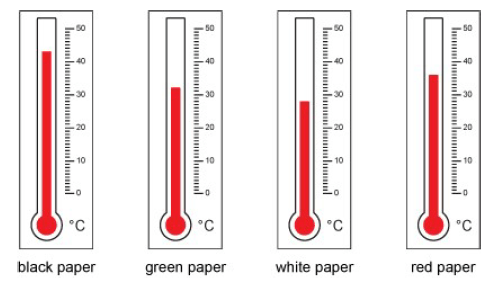
A. burning
B. sunlight
C. friction
D. electricity
What is B. sunlight?
Michael found a material while digging in his backyard. The material has a definite shape
and is purple in color. What did Michael most likely find?
A. a rock
B. a stone
C. a mineral
D. a fossil
What is C. a mineral?
What is a fossil?
A. a rock that is millions of years old
B. the model created by a scientist to study dinosaurs
C. the remains of an organism studied by scientists
D. an organism that has become extinct
What is C. the remains of an organism studied by scientists?
Ms. Lopez was given a plant as a gift from one of her students. She believes this plant is native to the Coastal Plains. Which question would best help Ms. Lopez determine if the plant is from the Coastal Plains?
A. Does the plant grow well in salt water?
B. Does the plant grow well in dry areas?
C. Does the plant grow well in sandy soil?
D. Does the plant grow well in cold areas?
What is C. Does the plant grow well in sandy soil?
The picture shows a flower.
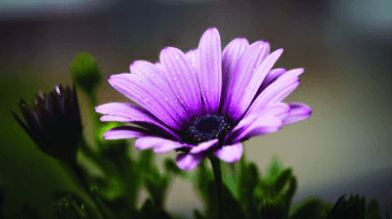
Pick three things the flower does for the plant.
A. It makes nectar for animals to eat.
B. It takes in water vapor from the air.
C. It forms the seeds to make new plants.
D. It attracts insects to the plant.
E. It helps the plant stay in the ground.
F. It helps to scare animals away.
What are A. It makes nectar for animals to eat, C. It forms the seeds to make new plants, D. It attracts insects to the plant?
Jackson is researching for his science project about pollution and he finds an article titled: "Fish in Danger as Huge Oil Spill Spreads". Which question might the article answer that will best help Jackson with his project?
A. Who is responsible for air pollution?
B. How can water pollution be avoided?
C. Where does most air pollution come from?
D. What are the effects of water pollution on animals?
What is D. What are the effects of water pollution on animals?
97. Danielle is making rock candy. She needs to boil water and then add
sugar. How can Danielle know when the water is ready for the sugar?
A. She can use a scale to find out the weigh of the sugar.
B. She can use a scale to find out the weight of the water.
C. She can use a thermometer to measure the temperature of the sugar.
D. She can use a thermometer to measure the temperature of the water.
What is D. She can use a thermometer to measure the temperature of the water?
Ms. Johnson is teaching her students the differences between rocks and minerals. Which table should Ms. Johnson use to best show the differences?
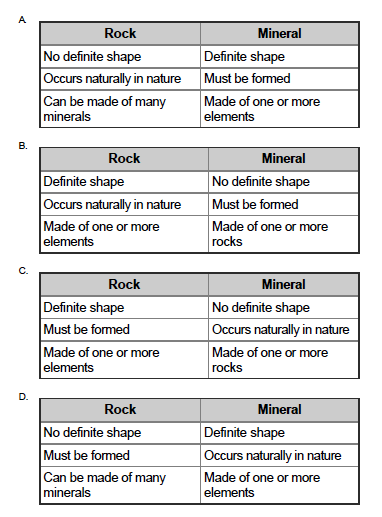
What is D?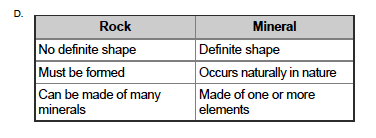
A picture of amber containing an ancient mosquito is shown.
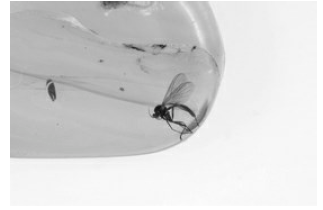
The presence of a mosquito in the amber reveals that
A. tree sap was the main diet for the mosquito population.
B. trees and mosquitoes lived in the same ecosystem.
C. trees produced sap as a defense against mosquitoes.
D. mosquitoes reproduced by laying eggs in tree sap.
What is B. trees and mosquitoes lived in the same ecosystem?
Which three organisms are most likely to be found in the coast habitat?
A. rattlesnakes
B. alligators
C. deer
D. sharks
E. boar
F. bears
What are A. rattlesnakes, C. deer, E. boar?
The Venus flytrap, which lives in bog environments, traps and digests insects. Why does this plant rely upon insects as a resource?
A. Bog environments do not have enough water.
B. Insects contain important plant hormones.
C. The plant protects itself by eating insects.
D. The plant gets its needed nutrients from the insects.
What is D. The plant gets its needed nutrients from the insects?
Terry is hoping to reduce the amount of trash in the landfills. Choose two things that Terry can do to reduce waste.
A. buy food with more packaging
B. take aluminum cans to the recycle center
C. throw her styrofoam cup out the car window
D. use cloth bags to carry her groceries
E. buy many plastic bottles of water
F. use paper plates to eat her dinner
What are B. take aluminum cans to the recycle center, D. use cloth bags to carry her groceries?
The picture below shows what happened when two books were rubbed together.
What happened to the covers of the two books?
A. They became warmer because their surfaces were rubbed together.
B. They became cooler because their surfaces were rubbed together.
C. They became warmer because warm air was able to move between the two books.
D. They became cooler because cool air was able to move between the two books.
What is A. They became warmer because their surfaces were rubbed together.
A scientist wants to find out what type of mineral she has. What is the best way for her to find out?
A. She could look at the color, hardness, and shape.
B. She could look at the weight, hardness, and color.
C. She could look at the color, weight, and size.
D. She could look at the shape, size, and hardness.
What is A. She could look at the color, hardness, and shape?
Look at the picture of soil.
What type of soil is this?
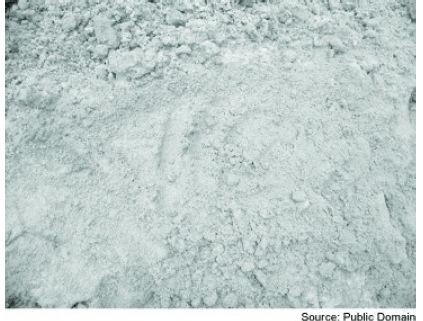
A. clay
B. loam
C. gravel
D. topsoil
What is B. loam?
Which features would be best for an animal living in the Piedmont region of Georgia?
A. white fur to blend in to a snowy environment
B. ability to build nests made of pine needles
C. claws to dig burrows deep in the sand
D. gills and body meant to live in saltwater
What is B. ability to build nests made of pine needles?
Which of these is an adaptation that helps an animal obtain food?
A. a frog's thick skin
B. a hawk's long claws
C. a peacock's colorful feathers
D. a skunk's stripes
What is B. a hawk's long claws?
Amanda and Michelle are arguing about the proper way to get rid of the plastic rings their soda cans came in. Amanda wants to just throw them in the recycling bin, but Michelle thinks they should cut them apart first. Which idea is better for the environment?
A. Michelle's, because birds can get caught in the plastic rings easily.
B. Michelle's, because the rings cannot be recycled unless they're cut apart.
C. Amanda's, because the rings have no bad effect on the environment.
D. Amanda's, because the rings cannot be recycled if they are cut apart.
What is A. Michelle's, because birds can get caught in the plastic rings easily?
Mia poured 36°F water into four different insulated jugs. She checked the water temperatures every hour for four hours. She put her results in the table below.
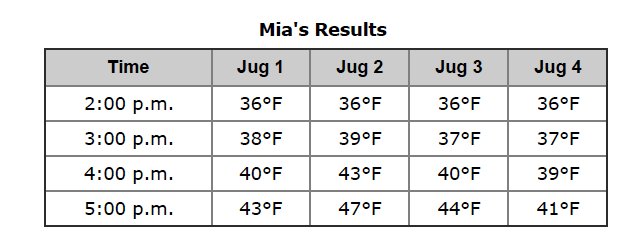
Which jug is the best insulator?
A. Jug 1
B. Jug 2
C. Jug 3
D. Jug 4
What is D. Jug 4?
The pictures show five rocks.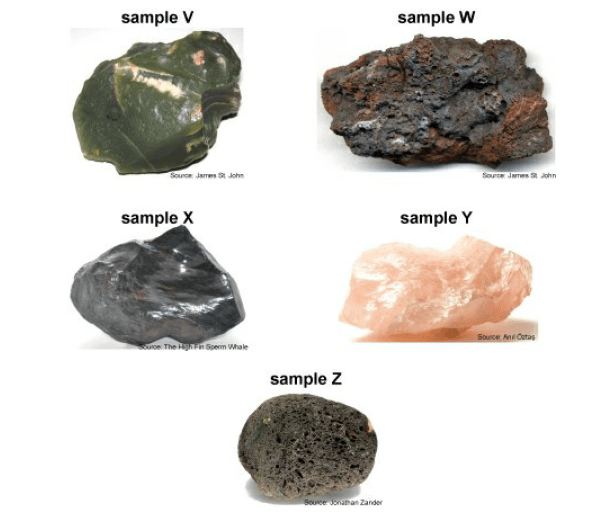
Pick three rocks that have a shiny luster.
A. sample V
B. sample W
C. sample X
D. sample Y
E. sample Z
What are A. sample V, C. sample X, D. sample Y?
Which soil held the most water?
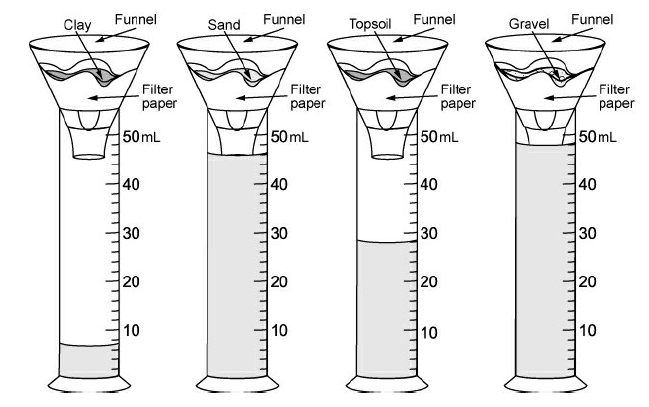
A. gravel
B. topsoil
C. sand
D. clay
What is D. clay?
The chart shows Georgia habitats and the plants and animals found in them.
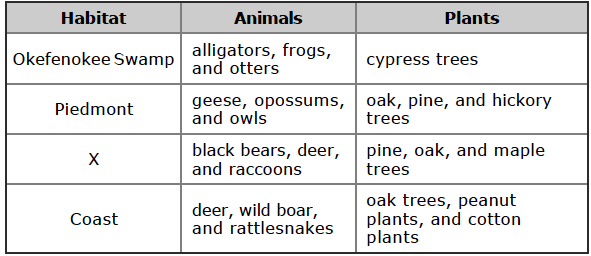
The letter X is most likely which type of habitat?
A. Ocean
B. Marsh
C. Mountain
D. Plains
What is C. Mountain?
Some plants have leaves with a waxy coating on them. How might this adaptation help the plant survive a drought better than a plant without a waxy coating on its leaves?
A. Less water would evaporate from the leaves.
B. Fewer animals would try to eat the leaves.
C. More insects would slide off of the leaves.
D. More energy would be absorbed from the Sun.
What is A. Less water would evaporate from the leaves?
Pick three ways that landfills can affect the environment.
A. They take up space that could be used by animals.
B. They make gases that enter the atmosphere.
C. They create new homes for animals to live in.
D. They create food sources for plants and wildlife.
E. They produce chemicals that enter the water supply.
F. They provide nutrients to the soil used by plants.
What are A. They take up space that could be used by animals, B. They make gases that enter the atmosphere, E. They produce chemicals that enter the water supply?
Ron pours hot cocoa into an insulated travel jug. The cocoa is still hot
two hours later. Which best describes why the cocoa is still hot?
A. The insulation stops the movement of heat.
B. The insulation slows down the movement of heat.
C. The insulation slows down the movement of cold.
D. The insulation stops the movement of cold.
What is B. The insulation slows down the movement of heat.
The table below shows the hardness of six minerals.
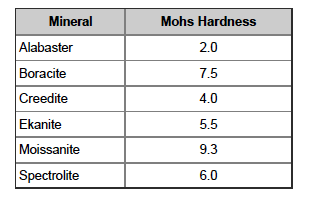
Using the table, which mineral will scratch Creedite but will NOT scratch Spectrolite?
A. Alabaster
B. Boracite
C. Ekanite
D. Moissanite
What is C. Ekanite?
A student collects three types of soil: sand, clay, and humus. He wants to investigate which soil drains water faster. Which set of steps should the student follow for the investigation?
A. Take three test tubes. Fill the first test tube halfway with sand, second with clay, and the third with humus. Take a dropper filled with water. Empty one full dropper of water into the test tube containing sand. Do the same with the other two test tubes filled with clay and humus. Record the time taken by the water to reach the bottom of the each test tube.
B. Take three test tubes. Fill each test tube with equal volumes of water. In the first test tube, add a known amount of sand. Add the same amount of clay and humus in the second and third test tubes respectively. Record the time taken by each soil to reach the bottom of the respective test tubes.
C. Take three test tubes. Mix an equal amount of sand, clay, and humus in each test tube. In the first test tube, add 5 mL of water and note the time take by the water to reach the bottom of the test tube. Add 10 mL of water in the second test tube and 15 mL of water in the third test tube. Record the time taken by the water to reach the bottom of each test tube.
D. Take one test tube. Add a known amount of sand in the bottom of the test tube. Add the same amount of clay on the top of the sand in the same test tube. Then add same amount of humus over the clay in the same test tube. Add 20mL of water over the humus layer. Record the time taken by the water to reach the bottom of the test tube.
What is A. Take three test tubes. Fill the first test tube halfway with sand, second with clay, and the third with humus. Take a dropper filled with water. Empty one full dropper of water into the test tube containing sand. Do the same with the other two test tubes filled with clay and humus. Record the time taken by the water to reach the bottom of the each test tube?
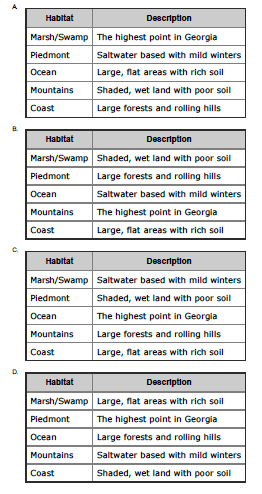 Which table correctly describes the habitats in Georgia?
Which table correctly describes the habitats in Georgia?
What is 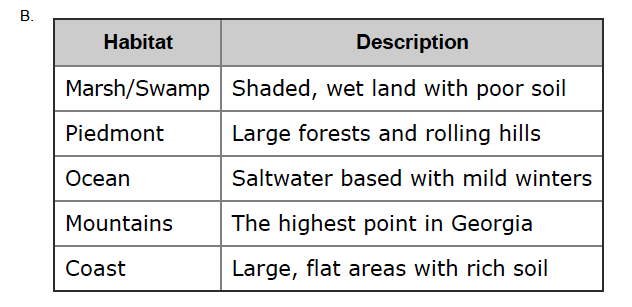
Sea turtles lay eggs in holes in the sand, then bury the eggs to keep them warm.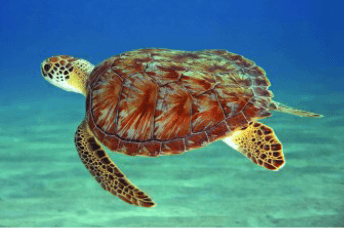
What feature do sea turtles have that helps them do this?
A. coloring that helps them blend in with sea grass
B. back flippers that help them dig in the sand
C. shells that protect them from predators
D. beaks that help them catch fish
What is B. back flippers that help them dig in the sand.
The table below shows Emma's pieces of clothing and the materials they are made from. Use the table below to answer any questions that follow.
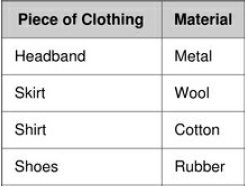
Which of the following is correct about the pieces of Emma's clothing?
A. The skirt and shirt are made from natural resources, but the headband and shoes are not.
B. They are all made from natural resources.
C. The shirt and shoes are made from natural resources, but the headband and skirt are not.
D. They are all made from man-made products.
What is B. They are all made from natural resources?